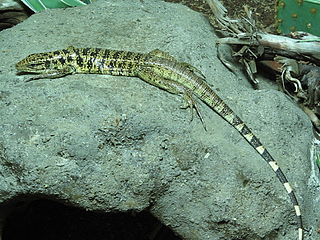
Teiidae is a family of autarchoglossan lizards native to the Americas. Members of this family are generally known as whiptails or racerunners; however, tegus also belong to this family. Teiidae is sister to the Gymnopthalmidae, and both families comprise the Teiioidea. The Teiidae includes several parthenogenic species – a mode of clonal reproduction. Presently, the Teiidae consists of approximately 150 species in eighteen genera.

Crocodilurus is a lizard genus with only one species Crocodilurus amazonicus, that belongs to the family Teiidae. Its common name is the 'crocodile' tegu, and is locally known as the jacarerana. This semi-aquatic predatory lizard has a flattened, paddle-like tail.

Tupinambis is a lizard genus which belongs to the family Teiidae and contains eight described species. These large lizards are commonly referred to as tegus. T. merianae, T. rufescens, and T. teguixin are popular in the pet trade. They are primarily found in South America, although T. teguixin also occurs in Panama.

The western whiptail is a species of lizard in the family Teiidae. The species is found throughout most of the southwestern United States and northern Mexico. Most of its populations appear stable, and it is not listed as endangered in any of the states comprising its range. It lives in a wide variety of habitats, including deserts and semiarid shrubland, usually in areas with sparse vegetation; it also may be found in woodland, open dry forest, and riparian growth. It lives in burrows. Major differences between this species and the checkered whiptail include the lack of enlarged scales anterior to the gular fold and the presence of enlarged postantebrachial scales. It was previously known as Cnemidophorus tigris, until phylogenetic analyses concluded that the genus Cnemidophorus was polyphyletic. Since it does not migrate, a number of forms have developed in different regions, several of which have been given subspecific names – for example the California whiptail, Aspidoscelis tigris munda.

Ameiva ameiva, also known as the giant ameiva, green ameiva, South American ground lizard, or Amazon racerunner, is a species of lizard in the family Teiidae found in Central and South America, and some Caribbean Islands.
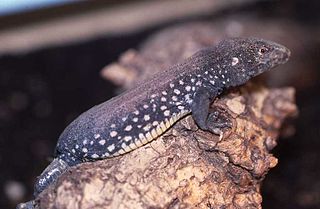
The Saint Lucia whiptail, also known commonly as the Maria Islands whiptail, the Saint Lucian whiptail, and Vanzo's whiptail, is a species of lizard in the family Teiidae. The species is indigenous to the Caribbean.

Holcosus festivus, commonly known as the Central American whiptail, the Middle American ameiva, and the tiger ameiva, is a species of lizard in the family Teiidae. The species is native to Central America and northern South America.

Holcosus quadrilineatus, also known commonly as the four-lined ameiva and the four-lined whiptail, is a species of lizard in the family Teiidae. The species is endemic to Central America.
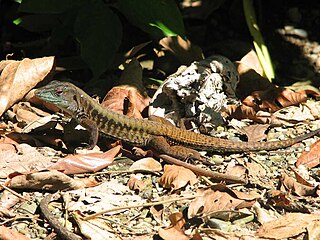
Holcosus leptophrys, also known commonly as the delicate ameiva and the delicate whiptail, is a species of lizard in the family Teiidae. The species is native to Central America and northwestern South America.

Holcosus undulatus, also known commonly as the barred whiptail, the metallic ameiva, and the rainbow ameiva, is a species of lizard in the family Teiidae. The species is endemic to Mexico. There are three recognized subspecies.
Censky's ameiva, also known as the Little Scrub Island ground lizard, is a species of lizard in the family Teiidae. It is indigenous to the Caribbean.
Plasmodium carmelinoi is a parasite of the genus Plasmodium.

Pholidoscelis wetmorei is a species of lizard in the family Teiidae (whiptails). The species is endemic to Puerto Rico. Its common names include the Puerto Rican blue-tailed ameiva, Wetmore's ameiva, and blue-tailed ground lizard.
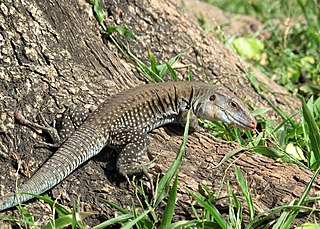
Pholidoscelis is a genus of lizards that belongs to the family Teiidae. All species are endemic to the West Indies.
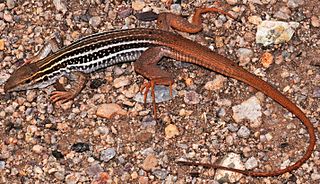
The canyon spotted whiptail is a species of lizard in the family Teiidae. The species is native to northwestern Mexico and the adjacent southwestern United States.
Holcosus anomalus, also known commonly as Echternacht's ameiva, is a species of lizard in the family Teiidae. The species is endemic to Colombia.
Holcosus bridgesii, also known commonly as Bridges's ameiva , is a species of lizard in the family Teiidae. The species is native to northwestern South America.

Holcosus chaitzami, also known commonly as Chaitzam's ameiva, is a species of lizard in the family Teiidae. The species is native to extreme southern North America and Central America.
Holcosus orcesi, also known commonly as Peters' ameiva, is a species of lizard in the family Teiidae. The species is endemic to Ecuador.


















